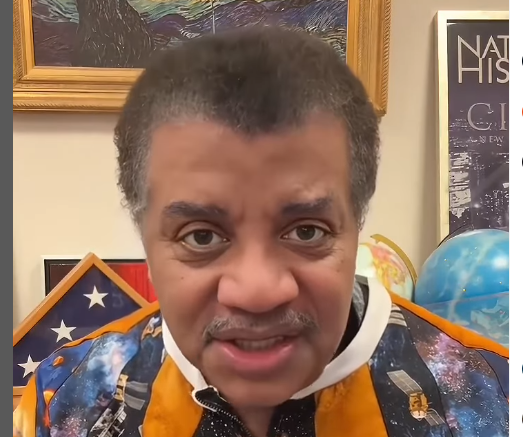Neil deGrasse Tyson, who is 6 feet 1 inch tall, takes up more area than just his mind when he walks into a room. He instantly exudes a natural presence that is extremely effective for a science communicator due to his height, which is startlingly similar to that of stars like Chris Hemsworth or Keanu Reeves. Viewers take note. Cameras react. Furthermore, his imposing size is surprisingly appropriate for the scope of the concepts he offers.

Tyson’s physical presence heightens the seriousness of his message, whether he is giving keynote addresses, arguing astrophysics on late-night television, or leading viewers through cosmic tales in Cosmos: A Spacetime Odyssey. He stands erect in front of the universe, representing both knowledge and authority, and he does more than merely describe it.
Neil deGrasse Tyson – Bio and Career Overview
| Name | Neil deGrasse Tyson |
|---|---|
| Date of Birth | October 5, 1958 |
| Age | 66 years (as of 2024) |
| Height | 6 feet 1 inch (185.4 cm) |
| Birthplace | New York City, United States |
| Education | Harvard (BA), UT Austin (MA), Columbia (PhD) |
| Occupation | Astrophysicist, Author, Science Communicator |
| Current Role | Director, Hayden Planetarium at the American Museum of Natural History |
| Spouse | Alice Young (married since 1988) |
| Children | 2 |
| YouTube Channel | StarTalk (4.8M subscribers, 792M+ views) |
| Notable Books | Astrophysics for People in a Hurry, Death by Black Hole |
| Awards | NASA Distinguished Public Service Medal, Public Welfare Medal |
| Source |
When Tyson is shown with other scientists or media hosts, this effect is particularly evident. Although it’s not everything, Height influences how we view authority. Tyson’s 6’1″ height frequently puts him a few inches above other people in group talks. He becomes a visual focal point, giving the viewer a subliminal indication that he is not only self-assured but also potentially at the forefront of the intellectual movement.
This phenomena is more than just conjecture. Even when the substance is the same, taller people are frequently seen as more credible, according to a large body of social psychology research. This impression enhances Tyson’s presentation of intricate astrophysical concepts. He uses a steady, rhythmic tone that, when combined with his assured demeanor, makes him seem both approachable and authoritative as he discusses black holes, dark matter, and time dilation.
However, Tyson’s height is more than just a matter of appearance. It has an intriguing intersection with the development of public science leaders. Earlier communicators, such as the more averagely tall Carl Sagan, depended mainly on narrative appeal and poetic language. Tyson, however, strikes a mix between scholarly understanding with a remarkable physicality that excels on contemporary platforms. podcasts. panels. TED stages and YouTube. His size aids in framing various formats and lends his presence a relatable, grounded weight.
This may seem like a small detail, but visual difference is important in a digital age where faces and voices are everywhere. Speakers who visually command attention are more likely to pause audiences who are scrolling through social media feeds. Overproduction and gaudy graphics are not necessary for Tyson to be seen. On their own, his size and well-spoken voice are incredibly effective instruments.
Tyson’s responsibilities have grown significantly in recent years, going much beyond traditional science lectures. His variety of media interaction has been especially creative, ranging from debates on flat-earth theorists on Twitter to appearances on The Big Bang Theory. Even in these lighthearted or humorous contexts, though, his height, stance, and facial expression convey a subliminal message: science is serious, but it’s also approachable, and he’s here to explain.
He reaches a rather uncommon equilibrium. While entertainers run the risk of trivializing the subject, scientists can come across as unduly technical or distant. Tyson fills that gap by continuing to be both intellectually demanding and eminently approachable. His inherent ease, which is partially a result of his towering stature, combines approachability with gravity when he is positioned next to celebrities like Seth MacFarlane or Stephen Colbert.
In this way, height joins a broader set of tools. It promotes a persona based on involvement, clarity, and trust. And that toolkit has proven especially helpful when the public is skeptical of science. Tyson’s presence lends steadiness and competency to conversations on space exploration funding, vaccine reluctance, and climate change.
Naturally, the significance of physical characteristics in forming public personalities should not be overstated. Tyson’s extensive impact is mostly due to his decades of research, innumerable essays, and books that make science understandable to the general public. His work establishing the Department of Astrophysics at the American Museum of Natural History and his position at the Hayden Planetarium are self-evident.
However, it’s hard to overlook how his physical presence enhances this legacy. Many young people find Tyson’s enthusiasm—and yes, his visual confidence—to be an invitation, especially those who don’t feel linked to science. He gives astrophysics a cool, not just palatable, feel.
Additionally, a towering figure looking upward while discussing stars, galaxies, and time itself has a profoundly symbolic meaning. His silhouette, which is frequently displayed in front of digital representations of spacetime or solar system models, conveys a sense of contemporary interest. Science should be experienced, embodied, and communicated rather than being hidden in textbooks.
Given his educational background, this becomes very poignant. Tyson’s path encompassed Harvard, UT Austin, and Columbia after he discovered his love for astronomy while visiting the planetarium he currently oversees as a child. His path feels as vast as the topics he covers, from a Bronx-born idealist looking through a telescope to becoming a popular name in scientific discourse.
Tyson’s case serves as an example of how science communication is becoming more graphic. He is not by himself. Similar strategies have been used by characters like Emily Calandrelli, Brian Greene, and Bill Nye to come across as captivating both physically and verbally. However, Tyson stands out due to his height, which adds a subtly seductive element.
His narrative approach, which frequently incorporates pop culture allusions and lighthearted banter, blurs the barriers between academic fields. The presentation, however, is never informal. It’s deliberate. He has the height of a leading man, the poise of a professor, and the delivery of a narrator when he takes the stage. And that mix is highly adaptable in the cutthroat media environment of today.











